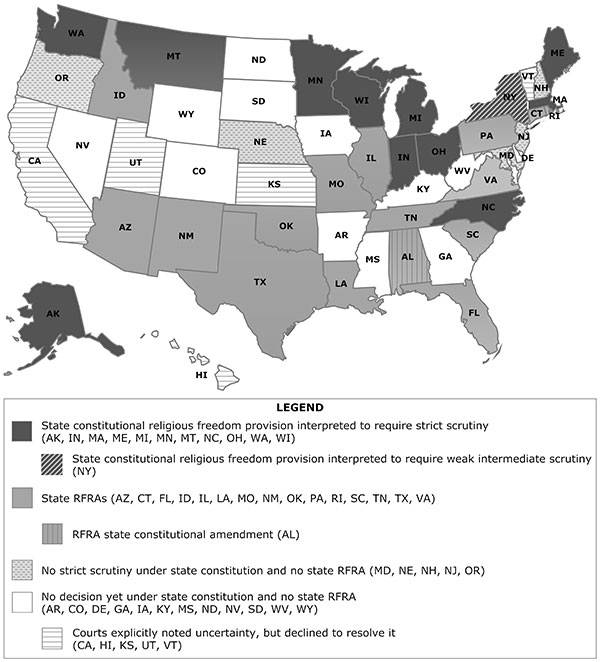This is Bill Clinton on November 16, 1993, signing the Religious Freedom Restoration Act, introduced by none other than Democratic Senator Chuck Schumer:

Now, to clear a few things up, I'm going to quote text from both laws for you the reader to compare:
From Indiana Code Section 1 IC34-13-9 :
Sec. 8. (a) Except as provided in subsection (b), a governmental entity may not substantially burden a person's exercise of religion, even if the burden results from a rule of general applicability. (b) A governmental entity may substantially burden a person's exercise of religion only if the governmental entity demonstrates that application of the burden to the person: (1) is in furtherance of a compelling governmental interest; and (2) is the least restrictive means of furthering that compelling governmental interest."
Sec. 9. A person whose exercise of religion has been substantially burdened, or is likely to be substantially burdened, by a violation of this chapter may assert the violation or impending violation as a claim or defense in a judicial or administrative proceeding, regardless of whether the state or any other governmental entity is a party to the proceeding. If the relevant governmental entity is not a party to the proceeding, the governmental entity has an unconditional right to intervene in order to respond to the person's invocation of this chapter.
From the Federal law 42 U.S.C. 2000bb-1 (Religious Freedom Restoration Act of 1993):
(a)In general
Government shall not substantially burden a person’s exercise of religion even if the burden results from a rule of general applicability, except as provided in subsection (b) of this section.
(b) Exception
Government may substantially burden a person’s exercise of religion only if it demonstrates that application of the burden to the person—
(1) is in furtherance of a compelling governmental interest; and
(2) is the least restrictive means of furthering that compelling governmental interest.
(c) Judicial relief
A person whose religious exercise has been burdened in violation of this section may assert that violation as a claim or defense in a judicial proceeding and obtain appropriate relief against a government. Standing to assert a claim or defense under this section shall be governed by the general rules of standing under article III of the Constitution.
Indiana's governor says his law mirrors the Federal Law. It does. Nearly word for word. So, why the selective outrage? Why isn't anyone upset at the Federal Law? Please I implore you the reader to enlighten me!

Now, to clear a few things up, I'm going to quote text from both laws for you the reader to compare:
From Indiana Code Section 1 IC34-13-9 :
Sec. 8. (a) Except as provided in subsection (b), a governmental entity may not substantially burden a person's exercise of religion, even if the burden results from a rule of general applicability. (b) A governmental entity may substantially burden a person's exercise of religion only if the governmental entity demonstrates that application of the burden to the person: (1) is in furtherance of a compelling governmental interest; and (2) is the least restrictive means of furthering that compelling governmental interest."
Sec. 9. A person whose exercise of religion has been substantially burdened, or is likely to be substantially burdened, by a violation of this chapter may assert the violation or impending violation as a claim or defense in a judicial or administrative proceeding, regardless of whether the state or any other governmental entity is a party to the proceeding. If the relevant governmental entity is not a party to the proceeding, the governmental entity has an unconditional right to intervene in order to respond to the person's invocation of this chapter.
From the Federal law 42 U.S.C. 2000bb-1 (Religious Freedom Restoration Act of 1993):
(a)In general
Government shall not substantially burden a person’s exercise of religion even if the burden results from a rule of general applicability, except as provided in subsection (b) of this section.
(b) Exception
Government may substantially burden a person’s exercise of religion only if it demonstrates that application of the burden to the person—
(1) is in furtherance of a compelling governmental interest; and
(2) is the least restrictive means of furthering that compelling governmental interest.
(c) Judicial relief
A person whose religious exercise has been burdened in violation of this section may assert that violation as a claim or defense in a judicial proceeding and obtain appropriate relief against a government. Standing to assert a claim or defense under this section shall be governed by the general rules of standing under article III of the Constitution.
Indiana's governor says his law mirrors the Federal Law. It does. Nearly word for word. So, why the selective outrage? Why isn't anyone upset at the Federal Law? Please I implore you the reader to enlighten me!


